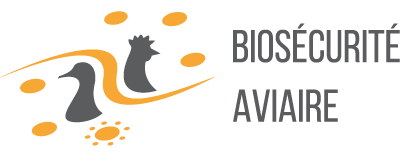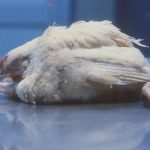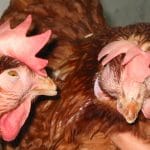Newcastle disease is a viral infection that can affect several species of domestic and wild birds, with various clinical expressions. Epidemics are caused by a virulent strain, but other strains are endemic in many countries. The disease may have a zoonotic character, with influenza syndrome and conjunctivitis, but this is rare. In France, Newcastle disease is a first-class health hazard.
The disease agent and its pathogenicity
Newcastle disease is caused by a serogroup 1 paramyxovirus (PMV1), a RNA enveloped virus.
Several strains are known, of variable pathogenicity, determined by intracerebral injection on 1-day-old chicks or by molecular diagnosis. They are classified as :
- Asymptomatic enterogenic = gastrointestinal tropism with no clinical signs. These strains are used to make vaccines.
- Lentogenic = low pathogenic (e. g. HB1, F, LaSota)
- Mesogenic
- Velogenic = very pathogenic (e.g. Milano, Herts, GB)
The virus causes the agglutination of erythrocytes of many species, hence the usefulness of agglutination and hemagglutination inhibition tests for diagnosis.
The virus is resistant in outdoor environments, and persists for long periods at room temperature, mainly in faeces.
Epidemiological data
Most bird species can be infected, but the clinical form is mainly expressed in chicken, and to a lesser extent turkey. All ages can be affected but sensitivity is increased in youngs. PMV1 also causes a lot of damage in pigeons (specific strain). Psittacids are often asymptomatic carriers. Humans in contact with the virus for the first time can develop conjunctivitis and influenza syndrome. In any case, they can, like cats and mice, multiply the virus.
The disease has a global distribution, but is most problematic in Africa, Asia and the Middle East. The velogenic strain, responsible for epizootic diseases, is now rare, but has already caused at least four pandemics. Lento- and mesogenic strains are endemic in many countries. Several European countries have been free from the disease for several years. At the end of 2017, one case affected a farm of 9000 pigeons in Orchies in the North of France. Today, and until the next OIE opinion, this department has lost Newcastle’s free status but remains unchanged for the rest of France.
Transmission occurs through aerosols and feces from infected birds (including cormorants and pigeons). Excretion can last for a long time (1 year in psittacids, 2 months in gallus). Contamination occurs by inhalation of infected aerosols or by ingestion of contaminated faeces. Indirect vertical transmission is possible, by exposure to the contaminated environment or by faeces on the shell. True vertical transmission is potentially existing, but contaminated eggs rarely hatch ; however, if they accidentally break at the hatchery, they can contaminate the entire brood, and exposed chicks can become healthy carriers. The virus can also be passively vectorized by poorly disinfected equipment.
The virus, depending on the strain, is more or less sensitive to disinfectants. However, it is sensitive to the heat used to destroy salmonella in egg products.
Live vaccines are a reservoir and vaccinated birds shed the virus. However, there is no evidence that vaccine strains can become more virulent.
Despite the possible isolation of the virus from wild birds, their role in the transmission of infection does not seem significant.
Clinical manifestations of the disease
The main clinical manifestations are found in Gallus (chicken). After an incubation period of 6-7 days, or even 3 to 4 weeks in rare cases, there are different clinical forms depending on the age of the infected animal and the virus strain. There are no clinical signs, necropsy or pathognomonic signs for this disease.
In adult subjects
- Lentogenic strain : Often no clinical signs. Weak respiratory signs and a fall in egg laying can be observed, with thin, rough or deformed egg shell and aqueous albumen.
- Mesogenic strain : Discrete acute form, with slight depression and anorexia. Birds may show weak respiratory signs, some nervous signs. Mortality remains low or zero. In layers, egg laying stops almost completely, with some poor quality eggs ; production resumes or not, depending on the stage of egg laying. If layers are well vaccinated, these signs will be reduced even more.
- Velogenic strain : Signs vary according to the tropism of the virus, but morbidity and mortality are high, almost 100%. Pneumotropic, viscerotropic and neurotropic forms of the disease can be distinguished. You can have shortness of breath, often marked. Several birds will develop violent green diarrhea, with conjunctivitis and paralysis, and death within 2-3 days. There may be cyanosis and edema of the periorbital tissues, with viscous ocular and nasal exudate. Some birds will show nervous signs : excitability, hypermetry 3 to 4 days after infection then tremors, swings, paresis, paralysis after 5 days and ending in convulsions.


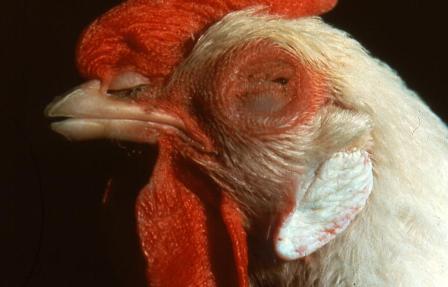
In young birds
- Lentogenic strain : Slow onset of respiratory signs (coughs, sneezes, rales, nasal and eye discharge). Some birds will have swollen heads. Even highly attenuated strains, such as B-1, can cause these signs in immunodeficient birds.
- Mesogenic strain : We have a sudden depression with prostration. The respiratory signs are marked. Nervous signs (torticollis) can follow or accompany respiratory signs. Usually, a small number show nervous signs (0-25% of the batch). Eventually, paralysis and mortality (up to 50%) are seen.
- Velogenic strain : Same signs as with the mesogenic strain, but with higher mortality and faster evolution.
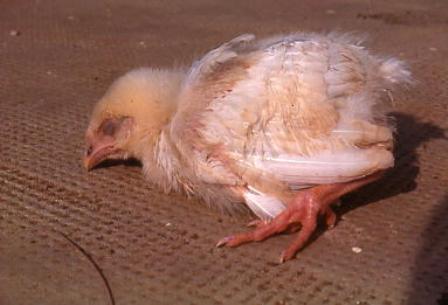

In other poultry, the signs vary according to the species. Respiratory symptoms are more pronounced in turkeys. Guinea fowl show mainly nervous signs. Pheasants and partridges have paralysis similar to what we see in Gallus.
Lesions
- The lento- and mesogenic strains cause few lesions. There may be a slight aerosacculitis, conjunctivitis and tracheitis.
- The velogenic strain causes many lesions, but they can vary from one individual to another. There is generalized carcass congestion and/or congestive splenomegaly and/or thymus hypertrophy. Respiratory lesions are localized to the trachea and air sacs, with severe inflammation ; facial edema may be observed. Respiratory lesions are rare except in cases of superinfection. The mucosa of proventriculus and gizzard, as well as the mucosa and serosa of the esophagus, are often hemorrhagic (petechiae or bleeding plaques). In the rest of the digestive tract, there is necrotic enteritis or multifocal bleeding, often involving lymphoid tissue in the mucosa, especially in the caecal tonsils. The ovaries show edema, bleeding and degeneration. In brooding birds, peritonites can appear due to an effusion of the egg yolk.
Ornamental birds often show no lesions or only discrete ones.
In turkey, the lesions are similar to those in chicken, but less severe.




The diagnosis
Epidemio-clinical diagnosis
Apart from acute forms, epidemio-clinical diagnosis is difficult. It is necessary to rely on a laboratory diagnosis.
The detection of the viral agent involves the isolation of the virus from embryonated eggs, from tracheal, oropharyngeal or cloacal swabs, and then the search for haemagglutinating activity. This isolation is difficult to achieve from birds with only nervous signs. Then, the pathogenicity assessment must be carried out, by molecular diagnosis or by injection on a 1-day-old chick. The intracerebral pathogenicity index (ICPI) is deduced :
- ICPI lentogenic strain : 0-0.4
- ICPI mesogenic strain : 1.2-1.6
- ICPI velogenic strain : 1.75-2
This method is beginning to be replaced by RT-PCR methods that are more sensitive and allow strains to be quantified and identified. The ICPI method defines the Newcastle strains that will be regulated (ICPI>0.7) by the OIE. They are supplemented by RT-PCR methods to identify the strain.
The samples to be taken are tracheal and cloacal swabs, or samples of faeces from live birds, or organs and faeces from dead birds.
Serology is possible by inhibition of hemagglutination, passive hemagglutination, ELISA. The interpretation of the results can be difficult depending on the vaccination or pathological history.
Differential diagnosis
Give priority to highly pathogenic avian influenza (first category health hazard), otherwise clinical signs may be confused with those of aspergillosis, mycoplasmosis, infectious laryngotracheitis, pasteurellosis.
Disease prevention and control
Health prevention
Given the ease with which the virus can be spread, preventive measures are essential. Control measures for imported animals, breeding animals and conventional hygiene, cleaning and disinfection measures are essential. Depending on the strain, the doses of disinfectants may vary. In the event of an outbreak, birds must be slaughtered, sheds and equipment disinfected, litter destroyed, the contaminated area blocked and animal movements near the outbreak restricted. Good biosecurity and quarantine measures remain the best measures to prevent infection with Newcastle virus. In addition, ring vaccinations are carried out around the outbreak. The area is declared free of Newcastle 6 months after the last clinical case and 3 weeks after slaughter.
It is a disease classified as a first category health hazard. The OIE conducts global health policies to regulate this disease.
Vaccination
There is no medical treatment but many vaccines are available. In France, vaccination is permitted : it is recommended for long-lived birds and is mandatory for pigeons and birds participating in public events.
Live vaccines with a lento- or mesogenic strain (La Sota, HB1, Clone 30, VG/GA) and inactivated vaccines are available.
The live vaccine is capable of multiplying in the body and provides short-term protection (2 to 6 weeks) ; the objectives of this vaccine are to stimulate the local organs of cellular immunity and thus create a barrier to the penetration of the wild virus, and to produce circulating antibodies that neutralize the virus.
The inactivated vaccine results in the production of antibodies in a significant and durable way (1 year of protection).
Vaccination with the inactivated vaccine is done by injection. Vaccination by live vaccine is recommended by air tracts ; for primary vaccination, droplets of 150-250 mm are recommended, nebulized at 30 cm from birds ; for booster vaccinations, finer droplets of 50-150 mm are used.
Vaccines available :
- Live : Avinew® (Mérial), Nobilis®Ma5+Clone30 (Intervet), Nobilis®ND Clone30 (Intervet), Nobilis®Hitchner (Intervet), Nobilis®ND LaSota (Intervet), Pestos® (Mérial), Poulvac® HitchnerB1 (Fort Dodge), Poulvac® LaSota (Fort Dodge), Sotasec® (Mérial)
- Inactivated : Binewvaxidrop® (Mérial), Imopest® (Mérial), Nobilis®IBmulti+ND (Intervet), Nobilis®IBmulti+ND+EDS (Intervet), Nobilis®newcavac (Intervet), Nobilis®RT+IBmulti+G+ND (Intervet), Nobilis®TRT+ND (Intervet), Ovo4® (Mérial), Poulvac®BI3 ND (Fort Dodge), Tur3® (Mérial)
